
views
Preparing Your Pet

Assess your pet's needs. All pets are different and have unique personalities. Some do well when left alone for longer periods of time and others do not. Pets that are more social, have medical conditions, or that are used to having lots of interaction with others may not do as well on their own for long periods of time. Also consider your pet's feeding schedule or if your pet likes to get into things and make a mess when you are not around. Younger pets may not be able to handle being left alone as well as more mature pets. If your animal has separation anxiety, a pet-sitter or a boarding house may be a good option.

Adjust your pet's schedule. Two weeks before your vacation, start leaving your pet home alone for longer periods of time. If you usually leave your pet at home while you are away at work, leave your house for a couple of hours after work each day. If you usually see your pet during the day, leave your pet at home while you are at work. This will prepare your pet to spend more time alone.
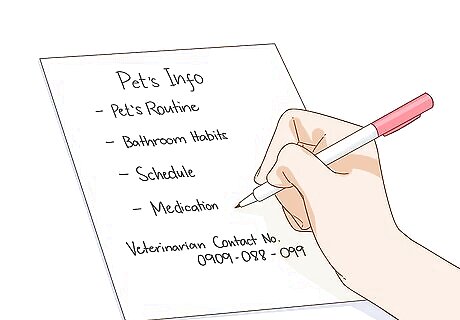
Write detailed instructions. If you are leaving your pet in someone else's care, it is important that you give him or her enough information to care for your pet. Leave your contact information, and the phone number of your veterinarian in case of an emergency. If your pet has any special dietary needs or likes specific treats or toys, write this information down. Include information about your pet's routine, bathroom habits, schedule, and any medications. Also include any information about your pet's personality that someone may need to know. Does your pet get excited when someone is at the door? Does your pet have a favorite hiding place? Be as detailed as possible when writing down the instructions. It is better to give someone too much information than not enough. Have your pet’s medical records accessible. Having your pet’s medical records in an easy-to-access place is helpful in case your pet becomes sick while you are away and needs to see a veterinarian. A smartphone app such as mPet is a great resource for storing and sharing your pet’s medical records.

Talk to your veterinarian. It is important that your pet is up-to-date on vaccinations and is healthy before you leave for vacation. This is also the time to ask about the best options for leaving your pet when you are gone. Your veterinarian may have recommendations for pet sitters and boarding options. Leaving your pet in a safe and trusted place will keep you from worrying while you are gone. They can also provide you with copies of your pet's medical records at that time.
Caring for a Dog

Try a pet sitter. Having someone come to your home will allow your pet to be comfortable in its usual environment. Decide how often your sitter will visit your pet. Will the sitter come by once a day or multiple times a day? It's best to use a professional sitter. Professional pet sitters can be found on the National Association of Professional Pet Sitters (NAPPS) or Professional Pet Sitters Inc. Pet sitters are also ideal for cats, who prefer to stay in their home environment and find being away from home stressful. Have a backup sitter in case of emergency.

Ask a friend or neighbor to check on your pet for you. Leave your pet at home and have a neighbor or friend come and check on your pet from time to time. Introduce your pet to your neighbor or friend so your pet is comfortable. Try taking a walk with your pet and the friend or have your friend over for a meal. Find out how much experience your friend or neighbor has with pets. You could also have your pet stay at the friend's or neighbor's house. If you are taking your pet to someone else's home, bring something from your home that will make your pet feel comfortable (e.g. bed, blanket, favorite toy).
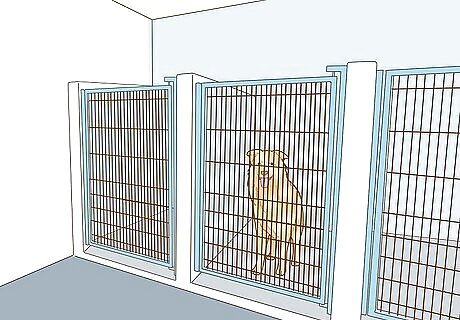
Take your pet to a boarding kennel. You can make arrangements to take your dog to a kennel. Make sure the kennel is certified by the International Boarding & Pet Services Association (IBPSA). Other questions you should ask the kennel include: the staff-to-pet ratio, clean and secure facility, is it climate controlled, frequency of exercise for the animals, grooming options, where will your pet be housed (e.g. individual crate or suite), and how much interaction your pet will have with other animals. Dogs do well at kennels because they are social animals. It's best to visit the kennel before you make arrangements for your pet to stay there. You want to be comfortable with wherever your pet is staying. Leave your contact information and your veterinarian's contact information with people at the kennel. Provide a copy of your pet’s medical records and vaccination records. These records can be safely transferred using a smartphone app that stores pet medical records and health information (such as mPet).

Try home boarding. Some individuals will offer boarding for a small number of animals in their home. This is good for animals who like to socialize and be with other animals. This setting is more intimate than a traditional boarding kennel. Ask your veterinarian for a referral. Evaluate the in-home boarding place the same way you would evaluate any other boarding kennel. Dog Vacay and Rover are good places to find in-home boarding for your dog. Go and check out the facility before you send your pet there.
Caring for Other Animals
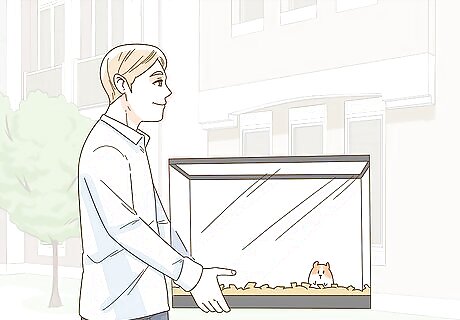
Relocate your caged pet. Caged animals such as hamsters, guinea pigs, rodents, reptiles, and amphibians can be taken to a friend's or sitter's home. Create a document that outlines the feeding and water needs, cleaning schedule, and temperature control. Pack all of the things that mimic your pet's environment at your home such as bedding, heated surfaces, and decorations. If the cage is not mobile, someone will need to come check on your pet daily.

Choose an environment that is similar to your home. A rabbit, ferret, or guinea pig is live bait in the wild. Relocating your pet to a home with canines or young children can be stressful and dangerous for your pet. If your pet is used to being in a quiet home with only adults, find a place that mimics that. The relocation environment is extremely important. Your pet can become disoriented and possibly sick from sudden lifestyle changes.
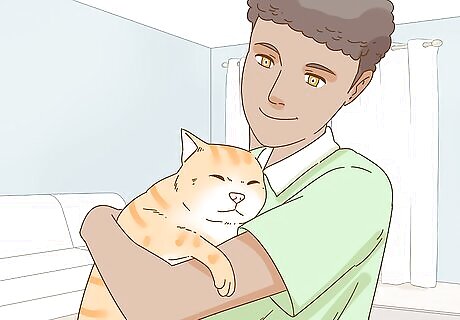
Get an in-home sitter for birds and cats. Birds and cats enjoy being in consistent, familiar environments. Birds may become restless and pluck their own feathers in unfamiliar environments. Similarly, cats can become distressed in different environments. It's best to find a sitter to stay in your home or stop by your home every day. If you have a bird, make sure that the sitter is comfortable and knowledgeable about birds. Cats should not be left alone at someone else's home. They are likely to wander, escape, and try to return home.
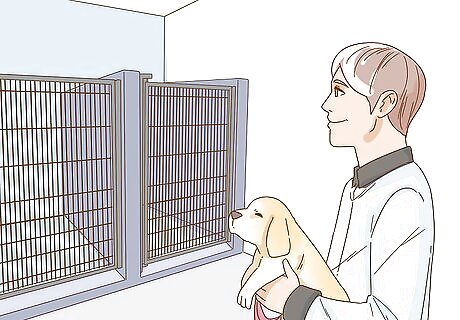
Take your pet to a kennel. A kennel should be the last resort for this type of pet. Make sure the kennel you choose caters to your pet. If your pet will be at a kennel that also houses dogs and cats, it is best if it will be housed in a separate area. Always check out the kennel before you allow your pet to stay there. Ask your veterinarian about boarding options for this type of pet. Some veterinarians provide boarding services as well.
Leaving your Pet at Home
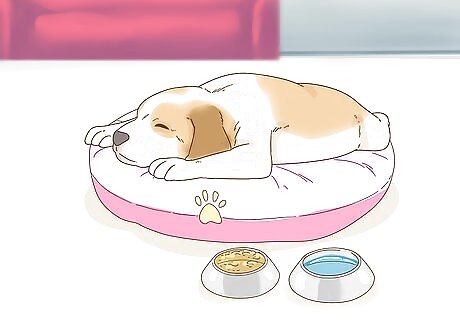
Make your home comfortable. If your pet will be staying at home on its own, keep the thermostat at a comfortable temperature for them. Maintain the thermostat as if you were still at your house. Close the doors to any rooms that you do not want your pet to get into. Make sure that your pet has a good bed and a way to go to the bathroom (doggy door or litter box). Leave food and water for your pet in a familiar place.

Pet-proof your home. Your home should be safe if you have a pet that roams freely throughout the house. Keep trash cans, toilets, and heating/air vents covered. Move any plants that may be poisonous, household cleaners, medications, and chemicals to higher shelves. Put away any toys, games, magazines, arts and crafts supplies, food, and household knick-knacks or decorations that may be tempting to your pet. Hide your clothing and shoes from your pet as well.
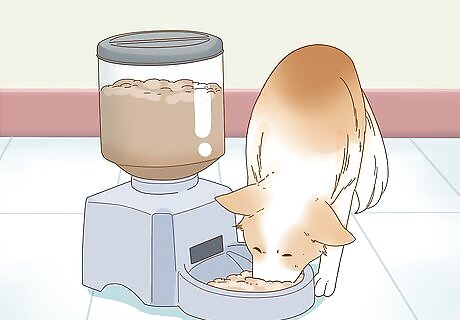
Use an automatic feeder. If you must leave your pet alone for a few days, use an automatic feeder. An automatic feeder will portion out your pet's food as many times a day as necessary. This will keep your pet from overeating. Also, some pets, such as cats, prefer eating fresh foods and would not be happy with a huge bowl of food left out. There are automated feeders for both food and water.

Consider getting a pet camera. If you have no one to check on your pet while you are away, a pet camera will allow you to monitor your pet. Some of these tools will allow you to interact with your pet as well. If you are unable to purchase a camera, there are surveillance apps that are more affordable. EXPERT TIP Darlene Antonelli, MA Darlene Antonelli, MA wikiHow Technology Writer Darlene Antonelli is a Technology Writer and Editor for wikiHow. Darlene has experience teaching college courses, writing technology-related articles, and working hands-on in the technology field. She earned an MA in Writing from Rowan University in 2012 and wrote her thesis on online communities and the personalities curated in such communities. Darlene Antonelli, MA Darlene Antonelli, MA wikiHow Technology Writer "I use a Wyze Cam Pan to keep an eye on my cat while I'm gone. It's not strictly a "pet cam" per se, but it features night vision and it pans for a larger view of the room! That way, I know if there are hairball surprises that I should avoid."

















Comments
0 comment